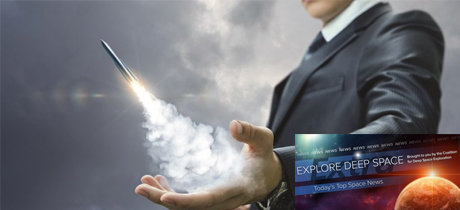In Today’s Deep Space Extra…. NASA’s Mars InSight lander has surpassed the halfway point on its journey Mars, with a positive systems and instrument checkout. Taiwan’s high level leadership makes a quiet visit to NASA. Beijing is not pleased.
Human Space Exploration
Vest designed to protect female astronauts from radiation being launched into space
KHOU-TV (8/19): As part of Exploration Mission-1 (EM-1), the first joint mission of NASA’s Orion capsule and Space Launch System (SLS), the crew capsule will be vacant. But NASA will be testing systems and hardware intended to lower the risks to future astronauts. Among them is Stem-Rad, wearable shielding developed to protect sensitive parts of the body from radiation, like that generated by a solar flare. Some of the shielding is specific to women.
SpaceX’s astronaut walkway installed on Florida launch pad
Spaceflightnow.com (8/20): An elevated launch pad walkway was installed at NASA’s Kennedy Space Center Launch Pad 39A in Florida on Monday. Astronauts will use the walkway in the not too distant future to climb aboard the SpaceX Dragon 2 for launching to the International Space Station. SpaceX, a NASA Commercial Crew Program partner, leased 39A from NASA four years ago.
Space Science
NASA’s InSight passes halfway to Mars, instruments check in
NASA/Jet Propulsion Laboratory (8/20): Launched May 5 from Vandenberg Air Force Base, California, NASA’s Mars InSight mission has passed the halfway point on its journey to a landing on the Red Planet on November 26. InSight is to become the first Mars probe to explore the planet’s subsurface activities. InSight and the probe’s multinational instrument suite appear to be in good shape.
A galaxy 11.3 billion light-years away appears filled with dark matter
Science News (8/17): The outer most stars in the distant galaxy Cosmic Seagall, appear to move along too fast to be propelled by galactic gravitation alone. The find indicates the hidden presence of “dark matter,” invisible matter whose composition and origins remains a mystery. The further stars in Cosmic Seagall are from the galaxy’s center, the faster they seem to speed along. The find and the explanation are led by a Chilean astrophysicist.
Other News
Talent gap jeopardizes space business, national security
This op-ed originally appeared in the August 13 issue of SpaceNews magazine
SpaceNews.com (8/20): The space race is back, inspiring innovators, investors and consumers alike, at a scale and scope unseen since the moon landing. But, do we have the talent to win? Since the dawn of the Space Age, governments have led the way in space. This time around; however, the private sector is revolutionizing the rocket launching and satellite scattering activity we hear about every day, while visions of planet roving, space station building, asteroid mining and dreams of far-flung colonies are helping to fire the public imagination. This new “space race” represents the potential for immense economic opportunity and innovation, as well as an explorer’s fevered dream. Beyond this; however, humanity’s future will depend on what we are able to achieve. Bill Beyer is a principal in the defense and national security practice at Deloitte Consulting LLP, a Coalition member. Mary Lynne Dittmar is the President and CEO of the Coalition for Deep Space Exploration.
Paul Allen’s Stratolaunch unveils plans for new family of rockets (and a space plane)
GeekWire.com (8/20): Stratolaunch, the space start up established by Microsoft co-founder Paul Allen three years ago, is providing new details on the planned versatility of the company’s large Stratolaunch carrier aircraft. That versatility is to support a new family of air launch vehicles, among them two types of rockets and a reusable space plane that could someday carry astronauts to orbit.
SpaceNews.com (8/20): The Pentagon’s latest assessment of Chinese space capabilities concludes that Beijing is stepping up space militarization efforts, though it claims otherwise. The report from the Defense Department is required annually, and the latest edition was released on Friday. Some specific conclusions include concerns for counter space weapons, kinetic-kill missiles, ground-based lasers and orbiting space robots. China has also stepped up its space as well as global surveillance capabilities.
Taiwan’s president makes landmark visit to NASA
NHK World of Japan (8/20): Taiwanese President Tsai Ing-wen stopped at NASA’s Johnson Center on Sunday, the first sitting leader from Taiwan to enter a U.S. government facility. She was briefed on NASA astronaut training facilities. Taiwanese media called the visit a new chapter in U.S. relations. Taiwan and the U.S. lack diplomatic ties. Sunday’s visit is characterized in the report as part of an effort led by President Trump to strengthen ties.
China criticizes Tsai’s visit to NASA
NHK World of Japan (8/20): China’s foreign ministry reacted strongly to Taiwanese President Tsai Ing-wen’s visit to NASA’s Johnson Space Center on Sunday. A spokesman charged the visit was part of a strategy for splitting China.

